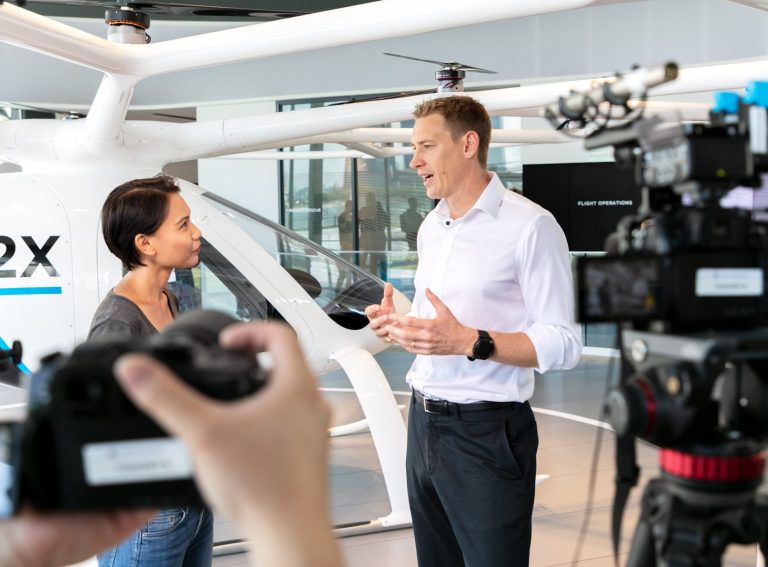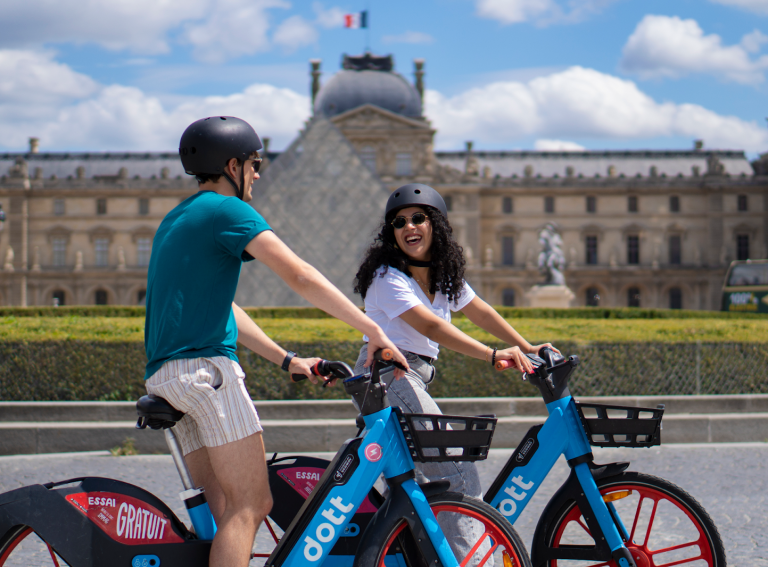Is Veo the ‘tortoise’ winning the race?
Creator of the shared micromobility industry’s first-ever dual-passenger vehicle and one of the few players globally to sustain profitability, the North American shared operator has kept its head down as it humbly stays in lane with a financially sustainable business model.
Candice Xie – one of the only female CEOs of a major shared scooter and bike company – says you’d be forgiven if you were less familiar with Veo. It has after all shied away from the ‘all press is good press’ sentiment that other companies have often welcomed.
The mission is ending car dependency in urban cities, but scaling in this industry can only be done at the right time and in the right way.
And for Veo the right time is now.
Zag: What personal challenges have you faced as one of the very few female CEOs in the new mobility industry?
CX: “It has at times felt like there’s a glass ceiling. If everyone in the room is a white male it can be hard to sell your business and relate if you’re different. When you look at me, I have all the traits that people won’t naturally invest into. I’m a female. I’m a first-time entrepreneur. I haven’t graduated from a school like UC Berkeley or Stanford. My company isn’t based in Silicon Valley, but rather started from West Lafayette, Indiana. What else? I’m an immigrant.
“I think all VCs have a subconscious profile they’re trying to fit, and I’m not that typical profile people will throw money at. Though it felt like a challenge when we were trying to get funding, I realise now it was a reward because we didn’t raise more money than we needed. We didn’t have easy money thrown at us and because of that we had to find alternative funding opportunities that were sustainable and supported us in continuous growth.”
Zag: What has been your approach given the lack of funding available?
CX: “I’m someone that is really focused on my company. I want to make sure the product is right, and our business model is right. I think the facts and results will speak volumes about who I am because this is the company we built. We must be doing something right if Veo has been EBITDA profitable since 2020. If you can show the world the result, that’s proof of who you are. I think this helps to elevate the women-led company statuses and lead investors to see women in the industry a little differently.”
Zag: What makes Veo’s business model sustainable?
CX: “Our philosophy is that running a successful business is like running a marathon. It’s not about how fast you start, but more how and when you can win the race. The last few years have not been the right time to aim for hockey stick growth in micromobility. We’ve been growing year on year, have entered many major US cities and a lot of these are exclusive or semi-exclusive contracts signed for between five and 10 years. We’ve been EBITDA profitable since 2020, with 95% of our current markets profitable and cash flow positive. The last few years have been about building the foundation and figuring out the business model to make sure we can scale profitability. Now, we think it’s the right time to scale.”
Zag: Why is now the right time?
CX: “While docked bikes have been around for longer, the micromobility boom truly started around six or seven years ago. Scooter share and bike share trips are skyrocketing and hundreds of cities are including micromobility in their long-term transportation plans. The cities are ready for it. They have seen the impact of micromobility and how it reduces car reliance, especially single occupancy vehicle usage, and how it’s also reducing carbon emissions and pollution. After a couple of years of education, the riders understand the convenience of micromobility and how to use it properly. So now feels like the right time for both riders and cities. There are many lessons in the industry to understand what went wrong and we’re analysing this to ensure we do the opposite. We’re continuing to move forward and even though we may look like the tortoise, we will win the race.”
Zag: Can you describe some of the mistakes you believe others made in the industry?
CX: “Too many hardware companies try to run as if they’re software companies, and this mistake has led many of them to the grave. A lot of them didn’t have the respect for how difficult it is to manage hardware, and to ensure the hardware is right for their customers. Many companies buy consumer-grade vehicles to scale quickly but they’re digging themselves into a rabbit hole because these vehicles break down more frequently and then companies are having to repurchase thousands of vehicles every quarter, wasting their resources. It also pushes the user away who might use one flimsy scooter and then decide to never come back to micromobility.
“Another mistake is companies striving to reach unicorn status as fast as possible. They raise too much too early and then are forced to spend it. I think our ‘frenemies’ in the US started this battle and then Europe hopped onto the trend. Everybody celebrates a trophy status but it can actually be the poison pill for a lot of companies that later go bankrupt, are delisted or have to fire loads of staff because they tried to raise more than they were ready for. The magical thing is startups can always find ways to spend money – the challenge is how to be disciplined in running your business. Many companies spent a lot of money in their early days when it was easy to raise during zero interest-rate periods. But it’s only when the funding stops do they realise it’s hard to cut down those G&A costs. The oxygen for startups shouldn’t be VC funding. It should always be revenue from the customer. This is where I think a lot of companies have gone wrong over the last few years – they’ve been prioritising the wrong things when raising and spending their money in order to reach valuations comparable to SaaS companies.”
Zag: How has Veo been spending its money?
CX: “We focused on our hardware to push out products that will help riders build a habit of using micromobility. Over the last few years, we’ve put out different types of vehicles from e-bikes to seated e-scooters to two-seaters because micromobility needs to be accessible for all to generate more ridership. There should be a micromobility option for everyone no matter their age, size, or body type. For example, I don’t think a stand-up scooter is the only form factor that makes sense because it rules out a lot of people who want to travel a longer distance but aren’t able to do so comfortably while standing.
“The reason we rolled out the Apollo dual-passenger e-bike is because we had seen users double-riding on our vehicles when it wasn’t safe to do so. So, we asked them why they were doing this and learned that some people found it more enjoyable to ride with their partners or their friends, and some people feel it’s easier to enjoy micromobility as a passenger instead of steering the vehicle themselves. And we thought: why not just provide them with a vehicle that lets them do this safely? That’s why we’ve put a lot of energy into R&D – even though it means we might take off slower, the payback comes quickly because users are sticking to our solutions and giving us a larger market share. Cities are welcoming us, too, because to encourage people to transition from cars to micromobility we need to fulfil a diverse set of rider needs.”
Zag: Where is Veo going from here?
CX: “Veo is very bullish about micromobility, and we will double down investment in cities, our products and our users. That’s the short answer.
“The long answer is the industry is here to stay and grow even if it has seen recent setbacks. Urban cities are undeniably becoming denser and facing serious challenges such as congestion and pollution. Shared electric micromobility is the perfect solution. Any recent setbacks are just short-term corrections – a survival of the fittest if you like. The industry is doing this selection to determine which business models can stay for the long-term. It’s just like in the 2000s when the internet was unstoppably becoming the future, but self-correction meant that only the strongest winners would come out the other side. We’re at a unique point in the micromobility industry where no one can stop it. Micromobility is here to stay because it has become an essential travel option for many people.”
Zag: What practical measures do you want to see organisations taking to improve the industry for women?
CX: “There needs to be a support system for women to learn from each other’s experiences and make sure that we can face these challenges without being drained. Personally, I’m a mentor for two other female-led startups in their seed funding stage to help them learn from my lessons and grow faster. If everyone can lend a hand to others, this will build a network and prove to the world that women are strong and capable. Businesses also need to reinvest in the community. At Veo, we hire whoever is the best fit for the role regardless of their background or gender. But diversity is actually in our DNA and I’m very proud of this because it’s something we’re practising on a daily basis.”
Zag: Who is one woman in the industry you would like to spotlight?
CX: “I admire Janette Sadik-Khan’s bold, thoughtful approach to transforming urban mobility. Not only did Sadik-Khan pave the way for micromobility in North America, she also carved out new space for women to lead in a traditionally male-dominated industry. A decade ago, when she was launching New York City’s bike share programme, I was studying Business at Purdue, where I would soon launch Veo’s first bike share system on campus. As someone whose company is bringing tangible change to city transportation systems, I look to leaders like Sadik-Khan who have led with a thoughtful approach to disruption.”





